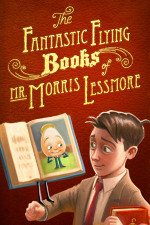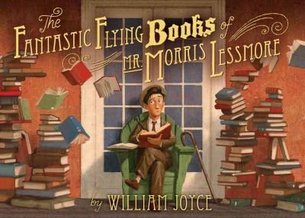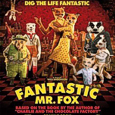On February 26, Fantastic Flying Books of Mr. Morris Lessmore co-directors William Joyce and Brandon Oldenburg entered the stage at the 84th Academy Awards to accept the Oscar for Best Animated Short. The film was the first effort from their Moonbot Studios and accomplished exactly what the creative duo set out to do: prove to the world that top quality animation could be crafted even in Louisiana.
Joyce and Oldenburg joined producer Lampton Enochs to create the comedic, heartfelt Morris Lessmore following turbulent periods in their lives.
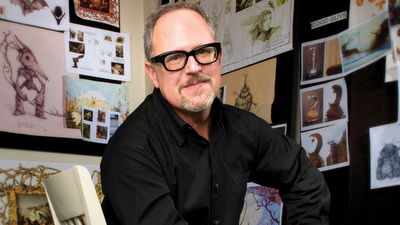
William Joyce
Writer-illustrator Joyce was already no stranger to animation. He was instrumental in establishing character designs for Pixar’s earliest films, Toy Story (1995) and A Bug’s Life (1998). Joyce then moved to the Disney Channel, where he created the Emmy-winning series Rolie Polie Olie (1998 – 2006). Soon Ice Age mastermind Blue Sky Studios called, wanting to adapt Joyce’s book Santa Calls. When that project was canceled, he and the studio collaborated on an original film, Robots (2005).
That same year, Joyce and Reel FX, co-founded by Oldenburg, launched Aimesworth Entertainments to produce video games, books and movies. For the latter medium, the company had three titles in mind: The Guardians of Childhood, The Mischievians and Dinosaur Bob & His Adventures with the Family Lazardo. In 2007, Joyce assisted Walt Disney Animation Studios in adapting his book A Day with Wilbur Robinson into the hit feature Meet the Robinsons.
But Joyce was growing weary of traveling back and forth between two coasts, desiring to work in his native Shreveport, Louisiana. Then the unthinkable happened: At age 18, Joyce’s daughter Mary Katherine died in May 2010. Fans poured their support to Joyce, as they waited to see how the tragedy would affect the artist.
Oldenburg, meanwhile, had been serving as Senior Creative Director at Reel FX since 1995, where he worked with clients such as Troublemaker Studios, Pixar, Disney, DreamWorks and Blue Sky Studios. Oldenburg acted as the visual effects supervisor for Spy Kids 2: The Island of Lost Dreams (2002) and the TV movie Halloweentown High (2004). From 1998 to 2009, he oversaw the joint venture between Joyce and Reel FX. The two men also collaborated on Halloween decor for Martha Stewart and parade floats for Disney. Oldenburg made plans to work on a film about Michael Jackson’s comeback tour – plans that were canceled upon the pop superstar’s sudden death in June 2009.

Brandon Oldenburg, left, William Joyce and Lampton Enochs
As for Enochs, he had been working as a location manager on films including City Slickers (1991), Honeymoon in Vegas (1992) and A Love Song for Bobby Long (2004). In 2002, he relocated with his family from California to New Orleans, Louisiana. While there, he created GWave Productions, producing a slate of television movies for the Disney Channel and ABC Family. But in August 2005, Hurricane Katrina tore through New Orleans, becoming the costliest natural disaster in U.S. history and killing 1,577 individuals in Louisiana. Following the disaster, Enochs moved to Shreveport.
Finding themselves in the same location, Joyce, Oldenburg and Enochs determined to pursue their passion by starting Moonbot Studios. They understood investors would be hesitant to finance a feature-length film by the fledgling animation house. Hence, the trio decided to craft a short film instead, using Joyce’s The Fantastic Flying Books of Mr. Morris Lessmore as its basis. To adapt the book, Joyce, Oldenburg and Enochs blended all mediums of animation, from traditional to computer to stop-motion. Using miniatures, the filmmakers were able to make significant, economical progress on Morris Lessmore before animators were hired.
Joyce wrote Morris Lessmore as a tribute to his mentor, William Morris of HarperCollins Publishers. In the story, the title character, bearing a remarkable resemblance to Buster Keaton, ponders the sensibility of life as he sits in New Orleans. His questions about life are channeled through his observations of the old tune Pop Goes the Weasel. “Why does the weasel go ‘pop’? Does it matter?” writes Lessmore in his journal. “If life is enjoyed, does it have to make sense?” The character finds the answers once he is whisked away from New Orleans by a storm which turns his world black-and-white and removes the words from his books. Along his path to self-discovery, Lessmore becomes the guardian of a colorful library full of books, each with a life of its own.
Morris Lessmore garnered much critical acclaim upon its release, with reviews praising Moonbot for having presented an emotionally engaging, complete narrative in 15 minutes when most animation studios need 90 minutes. The short earned numerous accolades as its traveled the film festival circuit, taking awards at SIGGRAPH, Cinequest Film Fest and the Nashville Film Festival. Ultimately, the positive buzz led to Joyce and Oldenburg accepting the Academy Award for Best Animated Short.

William Joyce raises his hands in victory as he and Brandon Oldenburg
accept the Academy Award for Best Animated Short Film.
“Look, we’re just these two swamp rats from Louisiana,” said Joyce in his acceptance speech. “There’s thousands of men and women […] through the beginning of cinema that have inspired us – movies that moved us more than we ever knew you could be moved.”
“It’s everything we try to do every day – to honor those people and those films,” he concluded. “And we’re going to keep on trying.”
Animated Views: The Fantastic Flying Books of Mr. Morris Lessmore really struck an emotional chord for me. Where did you get the idea for it?
Brandon Oldenburg: I’m glad it struck an emotional chord, definitely, because that’s what we were shooting for. We wanted your tears! [laughs]
AV: Well, you got them.
William Joyce: That’s awesome. It started as a picture book that I wrote. That’s one of the things I do – picture books and young adult novels. It was about a guy who had worked at my publishing house, HarperCollins, since 1949. His name was Bill Morris. He was just this great old publishing guy, a real mentor.
His first job at HarperCollins was to do a book signing for Salvador Dali. But Salvador Dali had insisted on being wheeled into the book signing on like a… What is it called?
BO: A gurney?
WJ: Like a thing where you’re getting an autopsy.
BO: Yeah, like a gurney on wheels.
WJ: And he had to be under a sheet, and he had to have a silver platter on his chest with three live lobsters crawling around on him. I don’t know. Anyway, Bill had a long, great history with publishing, starting with that auspicious event. [laughs]
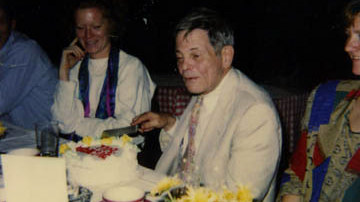
William Morris of HarperCollins Publishers cuts his retirement cake.
Bill was dying. I went to see him, and I wrote this story basically about him. It’s a play on words – his name, Bill Morris, and “Morris Lessmore.” Bill was a really small guy, about 5’2″, but he was a lion of the industry. He gave his whole life to storytelling. So I wrote this little parable about him.
Then Brandon and I started working together. I’d been doing computer animation kind of haphazardly since the beginning; I worked on Toy Story when there were about 20 people at Pixar. He also introduced me to Chris Wedge at Blue Sky. Chris and I did a movie together called Robots. Then I did TV, getting more into computer animation, and I really enjoyed it. It was nice. Doing books is a very solitary endeavor, whereas working in computer animation is a very sociable endeavor.
I’ve always loved movies. That was what my degree was in. Brandon had seen my picture books. He had helped found an animation studio in Dallas called Reel FX. In their early days, he had reached out to me with some hysterical correspondence. I drove over to Dallas to meet with them and went, “These guys remind me so much of Pixar and Blue Sky when I first got started.” So we started working together. We made a short test animation for what has now become Rise of the Guardians at DreamWorks. It will be coming out this year. We just really enjoyed working together.
Lampton Enochs, our third partner, came up to Shreveport after Hurricane Katrina. There was lots of film production in Louisiana that moved up to Shreveport after the hurricane. Lanmpton suggested that we form an animation company. That was when the three of us went, “Okay, we have to do a short film to prove what we can do, and that we can do this in Louisiana.” I suggested that we do Morris Lessmore, because it seemed to fit all the things that we wanted to do in animation. We could use CG; we could use miniatures. We could use 2D animation. It all seemed to fit into the story really nicely without seeming like we were just putting together this pastiche of things we liked for the sake of being avant-garde.
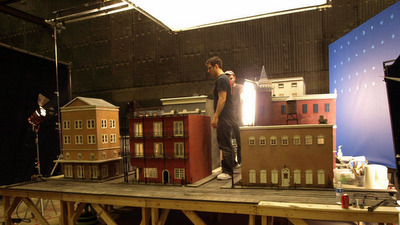
Animators film miniature sets for The Fantastic Flying Books of Mr. Morris
Lessmore, before adding computer and traditional animation to the scenes.
BO: From the beginning, we knew we had very ambitious goals, and we had everything going against us. So this is an amazing feat to have been a part of and to have helped accomplish. It took an amazing team. We were fortunate enough to find an amazing team to pull it off, and we’re fortunate enough to still have them around and doing great work on other things.
WJ: The day we started this company, we sat there with these guys who were going to be investors. They said, “Well, what’s the point of this short? Why are you doing it?” We said, “We want to be able to prove that we can do this; we want to be able to prove that we can do it in Louisiana, and we want to get nominated for an Academy Award to put us on the map.” And we never wavered from that. That was the goal. There was really the conviction, and – as Brandon says – some people call that insanity. [laughs]
BO: Yes, insanity to me is defined that way actually – at a certain point, when we have been working as long as we have together. We [individually] have been shooting for a short to be nominated for an Academy Award for 15 years. When you are 14 years in, you could start to look a little insane, and you know all of the things that can go wrong. How it happened is nothing short of a miracle.
AV: Bill, I read an article that said part of the inspiration for Morris Lessmore came from your visit to New Orleans after Hurricane Katrina. You saw organizations donating books to comfort the city’s children. Could you elaborate on that?
WJ: It was amazing! There were several organizations like First Book and Reading Is Fundamental. First Book by themselves got five million books into the hands of kids and adults after Hurricane Katrina and then Hurricane Rita. It was amazing to see these kids. They had lost their homes. They didn’t know when they would ever get back; they didn’t know where they would end up. A lot of times, they were separated from their family or portions of their family, while being surrounded by thousands of strangers in a room.
Usually, they were in some big sports arena, where they kept the lights on. Bad things would happen at night, so they kept the lights on all night. There were thousands of cots. There were no walls. I couldn’t think of anything more disorienting or depressing for a kid. Yet, you put a book in their hands, and you saw them sit there in these shelters, just totally absorbed in this book. The book encased them in this protective shield, and they were able to escape from all this uncertainty and sadness, by losing themselves in a story. That seemed powerful to us.
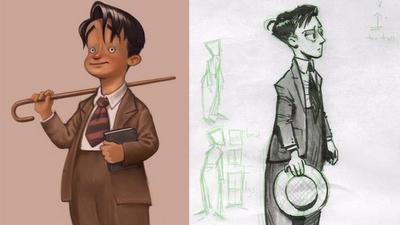
Joe Bluhm’s concept artwork for the title character of
The Fantastic Flying Books of Mr. Morris Lessmore
AV: If I understand correctly, you wrote Morris Lessmore on a flight to see Bill Morris. You read it to him, before he died a few days later. Could you describe his reaction, as you read the story to him? What did he say afterward?
WJ: Let me try to describe Bill Morris to you. He was this little leprechaun of a guy, but he was very smart and very witty. He had a very dry sort of humor, and he wasn’t an emotional person. He didn’t wear his emotions on his sleeve at all. He was sort of reserved, and he had a wicked wit.
Morris Lessmore has a fairly sentimental tone. Bill was sitting there in the room of his apartment, in his hospital bed surrounded by books. There was hardly anything in his apartment without books. He had this “jack-o-lantern” face, right? So I read the story to him. And then he slipped me his big ear-to-ear “jack-o-lantern” grin – which was a major compliment for Bill Morris. He didn’t hand out compliments. He said, “That was very nice. That makes me happy.” And that was basically like an opera from Bill. [laughs] I could tell it pleased him very much.
Bill would be so tickled that this [Oscar attention] is happening now. Some of our friends like Brian Selznick, who wrote The Invention of Hugo Cabret, knew Bill very well. Brian and I were texting the other day that it’s too bad Bill is not around to see what has happened to both of us this year. It would have pleased him to no end.
AV: One thing I loved was the film’s use of black-and-white. What traits determined whether a setting or a character was in color or black-and-white?
BO: I guess color represented a world full of inspirational stories. When a storm came along, it just sort of vacuumed that all away. Eventually, you look over at his book, which is black-and-white, void of any words. It took new stories floating into this world to bring it some color. Then once you’ve entered the realm of the library, everything is in color except Morris. It was enough for him to sort of do osmosis. He started to feel as though something was happening to him, and he was inspired. That’s why he stayed there.
When you read a book, there’s something about the experience that adds more richness to your life. And that’s certainly what happened to Morris. Then you see this happening to the visitors, the other wanderers.

All of our journals are begging for us to write down what we’re experiencing in our lives, so that others can read it later on. We all have a story. We all need to tell it. When we do start sharing our thoughts, we start to see how they sometimes affect people who may need that positivity in their lives.
WJ: So basically, Morris’ story got blown away. I mean, all the words in the book were gone. It wasn’t until he started writing again that the world went back to color.
BO: Yeah. There was the short answer. [laughs]
AV: I’m glad you brought up Morris’ book in the short, because I want to talk about it. I actually freeze-framed the short, so I could read the book’s pages.
WJ: [laughs]
BO: Uh-oh.
AV: Lessmore’s book starts out by talking about New Orleans and kind of endorsing it. Then, like you said, the words get blown out of the book. But when Lessmore rewrites the book, there’s no mention of New Orleans. Instead, he goes straight to writing about whether or not Pop Goes the Weasel makes sense.
BO: Well, I can tell you a couple of things here. It was because… [pauses] …we had to have something on the pages in the shots. [laughs]
I think I’m the one who came up with the words in Morris’ book. I was like, ‘I don’t know what the [heck] is on those pages!’ So I had a drink, and I sat down.
WJ: I think the question, though, is when you say, ‘Does it have to make sense?’
BO: [to Joyce] I was getting to that! [laughs]
WJ: [to Oldenburg] I’m helping ya’, I’m helping ya’.
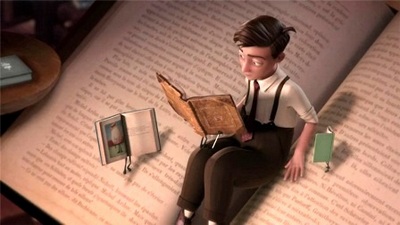
Morris Lessmore came to the question of “Does life have to make sense, especially if you’re enjoying it?” I think Morris came to the same answer we decided: “No, it doesn’t have to make sense, but that’s okay.”
I mean, people were sitting around in New Orleans, minding their own business, when this storm came and wiped everything away. There’s no sense to that. What was amazing was, five months later, they still had Mardi Gras. Brandon and I went down for it. It was the first time Brandon had ever gone to Mardi Gras. Here was this place that was almost wiped off the face of the Earth. The community was hanging on by a thread. By the time Mardi Gras rolled around, there were still huge sections of the city without electricity. But we had to have Mardi Gras. If we didn’t have Mardi Gras, it was like giving up.
Going there was the most amazing, life-affirming thing. We were pulling off of the highway and going onto the exit on Esplanade, which is one of the oldest streets in the French Quarter. As we drove along, things looked bad, still gray.
There were cars everywhere. It was like the last shot of Indiana Jones, where they were putting the Ark in that big warehouse, and as far as you can see, it’s just boxes. Going into New Orleans, it was cars as far as you could see, ruined. It was something like, I think, half-a-million cars that were flooded. They were all brown. We were asking, “What’s with all these cars?” They were all parked under the underpass. I said, “This is the weirdest thing I’ve ever seen.” That wasn’t how people usually park for Mardi Gras, and the cars were all the same color. Then I realized, “Oh, these cars were in the flood. They haven’t gotten rid of them.” It took a year to get all the ruined cars out of town.
We had been seeing that for 20 minutes, and we had seen flood lines on all the buildings for like an hour. Then we pulled onto Esplanade. As we were moving from the highway, onto Esplanade, we saw the Mardi Gras Indians marching down the street. They are Creole guys in this ancient part of Mardi Gras, and they wear the most amazing, Liberace-crazy plumage. They’ll spend $20,000 on these ostrich feathers that are the brightest colors you can imagine. They look like giant science-fiction birds walking down the street. So we pulled onto Esplanade, and the first thing Brandon and I saw was this flock of these guys. And we just went, “We’re still here! [laughs] Mardi Gras lives!”
Seeing those colors was amazing. We were…
BO: …coming out of the black-and-white world.
WJ: Yeah. Coming out of the black-and-white world.
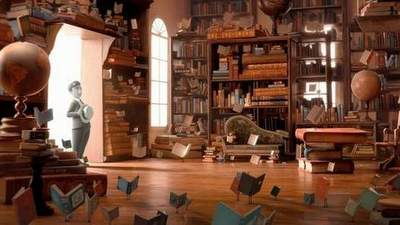
They were hanging over there like nothing, and they said, “Let’s have a party like we always do.” As silly as it sounds, that was the saving moment, I think, for the city.
Life is crazy – there’s nothing we can do about that. It’s one thing New Orleans has always understood. I mean, New Orleans is built under sea level. They know it’s a tenuous existence they’ve had for 200 years. So they have a certain joie de vivre about it. “Live for today, because the place could be gone tomorrow.”
BO: And you know what, it’s interesting. We were having gumbo at a friend’s house last night. One of our friends who’s a youth minister at a church started to read into all these meanings in Morris Lessmore – very spiritual meanings. And that’s what’s kind of cool about it too. I was raised Southern Baptist. My father was a minister. Components of anything I do always go back to my roots.
We want to tell a good story, and we want to remember those who came before us, who helped us find our stories. With both Bill and I, our life experiences have weaved their way into the story. We can’t define how. But when my mom watches the short, she cries. When people in this community watch it, they cry. And that’s cool. I think we did something right. When we hear other people have seen the short, and it pulled on their heart strings, we didn’t expect that.
We initially felt that the story might have been too personal. But it seems as though it’s relevant to a larger audience. We’re so fortunate for that.
WJ: And happy.
BO: Very happy.
WJ: But if you ask us why it worked, we just don’t know. That’s probably the fun part of making it work.
The Fantastic Flying Books of Mr. Morris Lessmore short and app
are now available to download at iTunes.
The Fantastic Flying Books of Mr. Morris Lessmore illustrated storybook
is available for pre-order at Amazon.
Our deepest thanks to William Joyce, Brandon Oldenburg and Jennifer Smith at H3O Communications.



